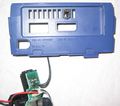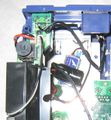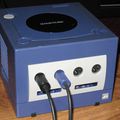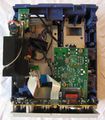« Retrocube » : différence entre les versions
Aucun résumé des modifications |
Aucun résumé des modifications |
||
| Ligne 94 : | Ligne 94 : | ||
and the output of the power supply is feeding the Pi. | and the output of the power supply is feeding the Pi. | ||
=== Final hardware === | |||
The position of the Raspberry Pi allow to put and remove the pi SD card in the original GameCube memory hole. | |||
The HDMI and Ethernet ports are available and the wire can go through the original video holes of the GameCube back. | |||
Here is the result : | |||
<gallery> | |||
Fichier:Retrocube front.jpg|thumb|Retrocube front | |||
Fichier:Retrocube back.jpg|thumb|Retrocube back | |||
Fichier:Retrocube inside.jpg|thumb|Retrocube inside | |||
</gallery> | |||
== Links == | == Links == | ||
Version du 28 avril 2014 à 23:25
Retrocube is a project of using a GameCube case for a retropie project (retro gaming using raspberry pi) This first part describe the hardware of this project.
Project
The aim is to build a retro gaming console using :
- A GameCube case
- A Raspberry Pi (with retropie)
- 2 GameCube gamepad
The console should run :
- Without keyboard
- The original power button from the GameCube should be working
- The original reset button from the GameCube should be working
- The front gamepad connectors (2) should be working
- The GameCube should be powered through the original power supply unit or any other supply unit
Hardware Part
GameCube opening tool
The GameCube uses 4 special screw. We need to build a tool to open it. Such a tool can be made using a simple Bic :
- Remove the ballpoint part
- Carefully, burn the end of the pen with a lighter
- Quickly put the burned end of the pen onto one of the 4 screw and wait for the pen to cool down
- Then you can use this tool to remove the 4 screw
GameCube dismantling
Safely dismantle all the parts
GPIO to gamepad
The gamepad will use the gamecon_gpio_rpi driver which use the following GPIO pins:
Carefully identify each pins, i use small paper to identify the interesting wire :
- 3.3V
- 5V
- PAD1
- PAD2
- PAD3
- GROUND
I found an adapter in an old dvd reader to connect the GPIO to the GameCube front panel. Each ( port 1 and port 2 ) gamecube controller should be connected to
- Pin2 to PAD2 or PAD3
- Pin3 to GROUND
- Pin6 to 3.3V
- Led to 5V
- Reset switch to PAD1
I used a continuity tester and the following connecter pinout to identify the wire :
and here is the result :
Power unit
To feed the pi with any power supply, i order an DC/DC converter on eBay ( 3A 5V ). So the Pi can be powered from the original power supply of the GameCube (12V) or by any other power supply (lower than 24V). The original power switch and the fan is used :
after the original power switch i soldered the DC/DC converter.
and the output of the power supply is feeding the Pi.
Final hardware
The position of the Raspberry Pi allow to put and remove the pi SD card in the original GameCube memory hole. The HDMI and Ethernet ports are available and the wire can go through the original video holes of the GameCube back. Here is the result :
Links
GameCube opening http://www.ifixit.com/Teardown/Nintendo+GameCube+Teardown/1727
gamecon_gpio_rpi driver https://github.com/petrockblog/RetroPie-Setup/wiki/gamecon_gpio_rpi
GameCube gamepad pinout http://www.int03.co.uk/crema/hardware/gamecube/gc-control.html
















